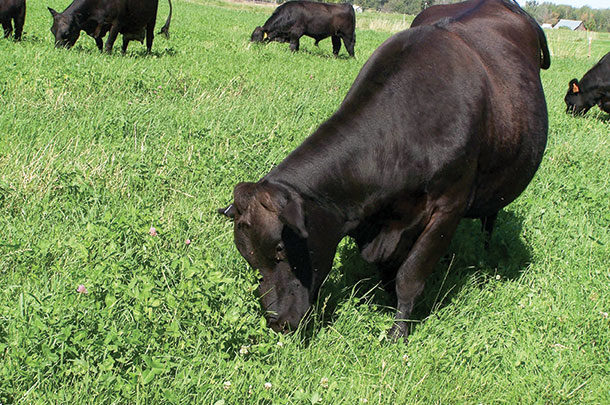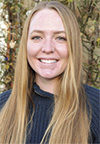“Legumes such as red and white clovers are a great high-protein nutrient source for sheep and cattle. They not only boost forage yield and quality, but their extensive root systems work to improve soil structure and nutrient filtration while nitrogen fixation increases pasture fertility,” Hall says.
“In the last decade, a lot of research has been conducted to improve cold and drought tolerance of some balansa and berseem clover varieties to give producers across the U.S. more versatility in their forage plans. U.S. producers have also been given the ability to tap into research from across the world for developments like the first successful cross of Caucasian clover and white clover by Aberystwyth University’s Institute of Biological, Environmental and Rural Sciences in Wales.”
As with any rotational grazing system, close management is essential for it to be successful, adds Serkan Ates, assistant professor at Oregon State University, whose research primarily focuses on pasture and grazing management for improved animal production and product quality.
“In a well-managed rotational grazing system, the forage supply should be monitored closely and adjusted to the appropriate stocking rate during a specific time,” he says. “Control of grazing, usually through permanent and temporary fences, is an important factor to improve utilization.”
Ates and Hall outline the best practices when incorporating clovers into rotational grazing systems:
Choose a clover species based on variety traits
“The type of clover used should be determined by what type of livestock you plan on grazing, your soil type and environment. For example, if you are grazing sheep, steer clear from red clovers because of potential fertility issues caused by high estrogen levels in red clover,” Hall says. “It is also crucial to understand not all species are created equal, so a focus needs to be placed on the quality and traits of a variety a certain species has to offer.”
Focus on dry matter mass instead of just plant height at first turnout
While it’s recommended pasture heights should be at least 2½ to 3 inches for sheep and 4 to 5 inches for cattle entering pastures, rotational grazing systems should also focus on pasture mass.
“The actual target pre-grazing pasture mass is highly interrelated with the target post-grazing residual mass and the rotation length, which varies based on the season and class of stock. In seasonally calving dairy operations, target pasture cover for dairy cows prior to calving is recommended to be in the range of 1,800 to 2,200 pounds dry matter per acre and generally be in the range of 2,500 to 2,700 pounds of dry matter per acre following calving,” Ates says.
“Pasture-based sheep production systems will achieve maximum feed intake on pastures 2 to 3 inches in height (or around 1,350 to 1,800 pounds of dry matter per acre), depending on the season.”
Give plants a rest
When plants are grazed too short, two things happen. First, energy reserves within a plant are depleted, increasing the timeframe for a pasture to recover. So what may have been a 30-day rest period could extend to 40 days. Second, it makes plants less resilient and more susceptible to drought and cold weather. The rate at which livestock can effectively graze pastures also needs to be kept in mind, reducing cattle’s ability to utilize pasture once a pasture is less than 2 inches tall, says Ates.
“Grasses accumulate carbohydrates in their bases and generally can be grazed closely as long as they are given a long enough time to recover. The recovery period is also related to rotation length, which is generally driven by the leaf appearance rate and fully expanded leaf numbers,” says Ates. “If the plants are defoliated before the recovery is complete, lack of energy will result in slower regrowth, prolonging the recovery period and eventually leading to death.”
Time grazing to hit plants at their highest nutritional value
To make the most out of a rotational grazing system, producers must get their timing down to hit regrowth when forage is at its optimum fiber and crude protein contents.
“There are no hard and fast rules to hitting forage at the exact right moment due to great variation coming from moisture, temperatures and individual paddock sizes,” Hall says.
According to Ates, grazing management must consider needs such as pasture cover targets, feed demand requirements and pasture quality, with leaf stage of the grasses in a pasture serving as an effective indicator of when a paddock is ready to graze.
“In spring, perennial ryegrass produces a fully expanded leaf every eight to 10 days with a lifespan of 21 to 28 days,” says Ates. “The optimal time to graze ryegrass pastures in intensive pasture-based dairy operations is at the three-leaf stage. Increasing rotation length to graze pasture after the three-leaf stage reduces pasture quality as older leaves begin to deteriorate.
Conversely, grazing pastures repeatedly at two-leaf stage will cause premature grazing, leading to decreases in forage yield and animal production potential of pastures.” ![]()
PHOTO: Cattle graze a mixed-species pasture of grasses and legumes, including clover. Timing of grazing can be as important as having the right species for optimal feed efficiency. Photo provided by Laura Mushrush.
Laura Mushrush is a freelancer with Agribusiness Communications. Email Laura Mushrush.
Using clovers to increase feed intake
Pastures in leafy conditions with legumes, such as clover, have better nutritional value than pastures with only grass species due to a legume’s ability to increase forage intake.
“Forage intake of grazing animals can be restricted by the high moisture and fiber contents of the forage. High legume content in pastures is desirable for greater forage intake and animal performance,” says Ates. “Legumes have a higher nutritive value than grasses because they have lower fiber concentrations and higher crude protein contents at the same harvest maturity.”









